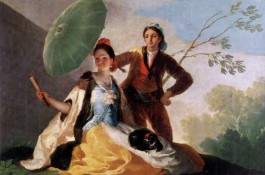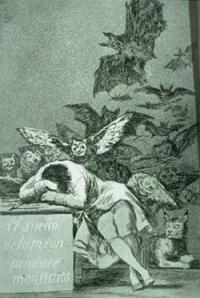Francisco de Goya y Lucientes
1746 - 1828 (Fuendetodos, España)

Top painters
Salvador Dalí
Pablo Picasso
Frida Kahlo
Diego Rivera
Goya was born on March 30, 1746 in the locality of Fuendetodos (near Zaragoza). His parents Jose Francisco de Paula Goya and Gracia Lucientes came from noble family of Aragón. His father worked as a painter and master gilder. Francisco Goya received education in the Pías School in Zaragoza and initiated in his 14 years artistic formation like an apprentice when he entered the factory of Jose Luzán, competent local painter although little well-known. Goya stayed four years.
In 1763 Goya left to Madrid to obtain a prize in the Academy of San Fernando. He did not win, but he met the Aragonese artist, Francisco Bayeu. Bayeu influenced remarkably Goya's formation and participated in fresco painting in the church of Virgin of the Pillar in Zaragoza (1780–1782).
In 1771 he traveled to Italy, where he stayed for one year. His activity during that time is not known; it should be mentioned his journey to Rome and that he took part in competition in the Academy of Parma. Around 1773 he returned to his country and there appeared in several projects, among them the one of the Cartuja of Dei Classroom, near Zaragoza, in 1774, where his painting were model upon the best fresco paintings made for the church of San Antonio of Florida in Madrid, in 1798.

In 1789 Carlos IV appointed Goya as a Painter to the King. This is the most prestigious position for an artist in Spain, and also comes with a steady income. He had a special position in the courtyard, which caused that the Museum of the Prado in Madrid inherited a very important part of his works. The tapestry carpets that Goya made at the end of the decade of 1780 and the beginnings of 1790 were very appreciated for the amiable and breezy vision that offers the Spanish daily life. With this work he revolutionized the industry of the carpet. He made portraits like: Carlos III, Hunter (1786–1788); The Dukes of Osuna and their children (1788) both in the Museum of the Prado in Madrid; or the picture Marquise de Pontejos (c. 1786, National Gallery, Washington). Two of them are the most famous: Maja Naked (1800–1803), Maja Clothed (1800–1803). In the winter 1792 he went through a serious disease that left him totally deaf and this moment marked further influence in his artistic expression.

Between 1797 and 1799 Goya drew and etched first of his great series of engravings, Los Caprichos in which he satirizes the social defects and the superstitions of that time. After that appeared some series as Disasters of War or Fatal Consequences of the Bloody War in Spain with emphatic Bonaparte and other whims, (1810) and Disparates (1820–1823). In 1812 died his wife but before her death he became in relationship with Leocadia Zorrilla de Weiss, who accompanied him until the end of his days.
In 1815 he launched a new series of illustrations – Tauromaquia
– composed of thirty and three engravings, where Goya developed the
historical theme of bullfight, apparently to illustrate a text of Moratín
father and feats of contemporary bullfighters, with an excellent technique and a
totally mature style. The horrors of the war left a deep trace in
Goya's mind.
 In 1814 Goya painted well-known Second of May
in 1808 in Madrid: the fight with the mamelucos and the Third of May in
1808 in Madrid: the later executions in the mountain of Prince Pío and other
paintings (Museum of the Prado). He used direct simplicity in the portraits that
he painted like the Family of Carlos IV (1800, Museum of the Prado), where he
showed the real family without the habitual idealization. In 1819 Goya sketched
more stirring religious compositions like The Last Community of San Jose de
Calasanz and Christ on the mountain of the Olive trees. Famous Black Paintings
(c. 1820, Museum of the Prado) are the most outstanding works of the last years.
In the beginning they were painted like fresco painting on the walls of the
house that Goya had in the outskirts of Madrid and in 1873 they were
transferred to linen cloth. It is necessary to emphasize: Saturn (c.
1821–1823), Aquelarre, el gran cabrón (1821–1823). The predomination of the
black, brown and gray tones demonstrated that Goya's character became more and
more shady. In 1824 Goya left like expellee for France. In Bordeaux worked with
the technique of the lithography and made a series of bullfighting scenes.
In 1814 Goya painted well-known Second of May
in 1808 in Madrid: the fight with the mamelucos and the Third of May in
1808 in Madrid: the later executions in the mountain of Prince Pío and other
paintings (Museum of the Prado). He used direct simplicity in the portraits that
he painted like the Family of Carlos IV (1800, Museum of the Prado), where he
showed the real family without the habitual idealization. In 1819 Goya sketched
more stirring religious compositions like The Last Community of San Jose de
Calasanz and Christ on the mountain of the Olive trees. Famous Black Paintings
(c. 1820, Museum of the Prado) are the most outstanding works of the last years.
In the beginning they were painted like fresco painting on the walls of the
house that Goya had in the outskirts of Madrid and in 1873 they were
transferred to linen cloth. It is necessary to emphasize: Saturn (c.
1821–1823), Aquelarre, el gran cabrón (1821–1823). The predomination of the
black, brown and gray tones demonstrated that Goya's character became more and
more shady. In 1824 Goya left like expellee for France. In Bordeaux worked with
the technique of the lithography and made a series of bullfighting scenes.
Goya died in Bordeaux on 16 of April, 1828, surrounded by his daughter-in-law and her grandson Mariano. The funeral was celebrated in the church of Nôtre Dame and the inventory of his property sample numerous of his work. He was buried in the cemetery of the Cartuja, where his remains rested until 1899 when they were exhumed and in 1919 they found definitive rest in the church of San Antonio de la Florida in Madrid, Spain.
Interesting links - Francisco Goya
Francisco Goya in Wikipedia
Francisco Goya - Artcyclopedia
Francisco de Goya (1746–1828) and the Spanish Enlightenment
Francisco de Goya - Webmuseum
Francisco de Goya
Francisco de Goya Work Collection
